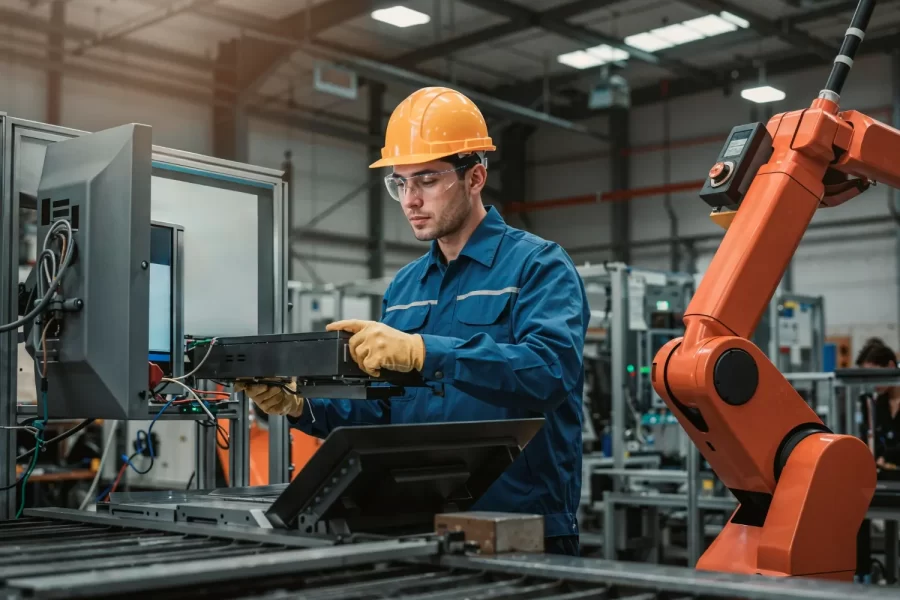
With the rapid development of technology, robot automation in manufacturing processes is no longer a luxury but a necessity. Robotic systems, once accessible only to high-budget companies, are now finding their place even in small and medium-sized enterprises. This is because robots offer many advantages in different sectors, such as speeding up the production line, minimizing human error, and increasing quality. This technological transformation has touched almost every branch of industry. In particular, sectors that use robots offer unmissable opportunities for companies that want to increase their operational efficiency and get ahead of the competition. So, in which areas do we see sectoral robot solutions? Let’s take a look together.
Which Sectors Benefit from Robot Technology?
Looking today, the sectors that use robots are spread across a wide range. Robots are actively involved in many fields, from manufacturing to healthcare, from logistics to agriculture. Industries, especially those with mass production, reduce labor costs and achieve a more standardized production quality thanks to robot automation. The role of robots is significant not only in physical work but also in operations that require fine craftsmanship.
The first sectors that come to mind when it comes to industrial applications are automotive, electronics, food, pharmaceuticals, and healthcare. Each of these increases its operational power with sectoral robot solutions tailored to its own dynamics. Also, robots are frequently preferred in different sectors for areas such as warehouse management, packaging, assembly, and quality control.
How Does the Automotive Industry Use Robots?
Automotive robots are one of the areas where this technology is most intensely used. This is because vehicle production requires high precision and fast production cycles. At this point, robot automation comes into play to exceed the limits of human power. Operations such as welding, painting, assembly, and transport are generally carried out by robots in the automotive sector.
Automotive robots, in particular, perform repetitive operations on the production line with great accuracy. This ensures a standard in product quality and saves time. In addition, the use of robots is a great advantage in terms of occupational safety. Employee health is protected by using robots for dangerous or non-ergonomic jobs. In short, the automotive sector is one of the areas that benefits most from the opportunities offered by robot technology among industrial applications.
What Do Robots Do in the Food Sector?
When it comes to food production, hygiene, speed, and precision are at the forefront. For this reason, the use of food production robots has become quite widespread in recent years. Operations such as packaging, weighing, product sorting, palletizing, and labeling can be made much more efficient with robots.
In this sector, where hygiene is of great importance, robot automation is preferred to minimize human contact. Since robots are designed to comply with standard cleaning procedures, they are also very advantageous in terms of food safety. In addition, their ability to work day and night without stopping significantly increases production capacity.
Food production robots are also effective in reducing waste rates. Thanks to their fast and error-free processing capability, both costs are reduced and continuity in product quality is ensured. This increases the credibility of brands in the eyes of consumers.
What Is the Advantage of Robots in Electronics Manufacturing?
The electronics sector has production processes that require micron-level precision. This is where the electronic assembly robot comes in. Operations such as the correct placement of tiny components, soldering, and testing are carried out by robots with great meticulousness.
Especially in processes such as motherboard production, mobile phone assembly, or precise sensor placement, robot automation has become a must. These operations, which are both time-consuming and prone to a high rate of error when done by hand, become fast and flawless thanks to robots.
The electronic assembly robot can easily adapt to different products with its flexible production capability. Moreover, since hundreds of thousands of parts can be produced with the same craftsmanship, quality control is easier and production costs are significantly reduced. This provides a significant gain in terms of industrial applications.
How Do Robotic Systems Work in the Healthcare Sector?
With the developments in medicine in recent years, robotic systems in healthcare have also created a great revolution. Robots are involved in many fields, from surgical robots to patient transport systems, from laboratory automation to drug preparation devices.
Robotic systems used in the surgical field, in particular, allow doctors to intervene at the micron level. This enables less invasive surgeries to be performed, the recovery process of patients to be accelerated, and the risk of complications to be reduced. At the same time, physical therapy robots help patients regain their mobility during the rehabilitation process.
Robotic systems in healthcare used in laboratories automate many processes, from the analysis of samples to the classification of test results. This saves time and minimizes human error. Therefore, among robots in different sectors, the healthcare sector stands out as one of the most critical areas that directly affects human life.
Today, the sectors that use robots are becoming more diverse and widespread every day. Whether on the production line or in the service sector, robots increase efficiency while minimizing the margin of error. Automotive robots, food production robots, electronic assembly robots, and robotic systems in healthcare all offer solutions developed specifically for sectoral needs. Thanks to this transformation, automation in production has become not just a technology preference, but an inevitable part of competition.
